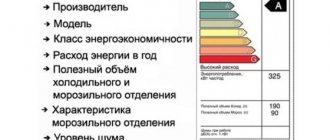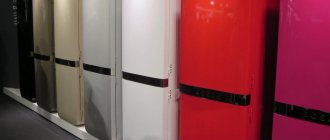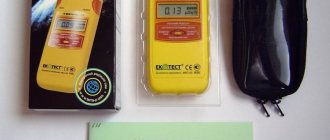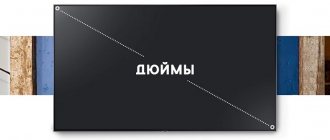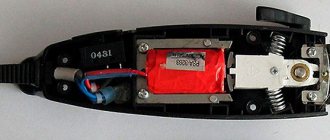Last updated April 8, 2021
A coffee machine is an automated household appliance designed for brewing coffee and other tonic drinks.
This kitchen device has advanced functionality and a wide range of supported programs for preparing coffee products.
Also, the design of the devices in question may contain additional elements with which you can heat cups, simultaneously pour the drink into several servings and whip up milk froth. This article contains the best coffee machine models that can be purchased in 2021.
Why do you need a power table for household appliances?
When renovating a kitchen, to calculate the cross-section of the electrical cable for the kitchen wiring, you need to understand what household appliances will be used in the kitchen. To calculate the cable cross-section, you need to know the power consumption of the household appliances used. Below are three tables, one of which is a table of the power of household appliances, averaged, but accurate enough to calculate the cross-section of the electrical cable when renovating a kitchen.
Two other tables allow you to calculate the cross-section of the cable cores needed to power these devices based on the total power of household appliances.
Table 1: Power consumption/Current strength/Cable cross section (wire)
| Power, W | Current strength, A | Wire cross-section, sq.mm |
| 200 | 0,9 | 0,1 |
| 400 | 1,8 | 0,2 |
| 800 | 3,6 | 0,4 |
| 1 000 | 4,5 | 0,5 |
| 1 500 | 6,8 | 0,7 |
| 2 000 | 9,1 | 0,9 |
| 2 500 | 11,4 | 1,1 |
| 3 000 | 13,6 | 1,4 |
| 3 500 | 15,9 | 1,6 |
| 4 000 | 18,2 | 1,8 |
| 5 000 | 22,7 | 2,3 |
| 6 000 | 27,3 | 2,7 |
| 7 000 | 31,8 | 3,2 |
| 10 000 | 45,5 | 4,5 |
Table 2: Power of household appliances according to the passport
| Electrical appliances in the kitchen (comparison table) Electrical appliances | power, kWt | Duration of operation during the day |
| Toaster | 0,8 | 10 min |
| Coffee maker: | 0,8 | |
| brewing coffee | 12 min | |
| keeping hot | 3 hours | |
| Dishwasher | 2 | 2 loads daily, 24 min per wash cycle |
| deep fryer | 1,5 | 17 min |
| Kettle | 2 | 10 min |
| Oven | 2 | 2 hours |
| Plate: | 8 | |
| large heating element | 1 hour | |
| small heating element | 1 hour | |
| Fridge | 0.2 (compressor + lamp) | 7 h (including shutdown time using relay) |
| Freezer | 0.2 (compressor + lamp) | 7 h (including shutdown time using relay) |
| Microwave | 0,85 | 10 min |
| Microwave oven combination | 2,65 | 30 min |
| Roaster | 1,5 | 30 min |
| Instantaneous water heater | 2 | 30 min |
| Washing machine | 3 | 1.5 h |
| Clothes dryer | 3 | 30 min |
| Food processor | 0,4 | 15 minutes |
| Hood (ventilation) | 0,3 | 30 min |
Table 3: Power of household appliances and lighting
| № | NAME | POWER | NOTES |
| LIGHTING | |||
| 1 | Incandescent lamp | 60W/75W/100W | |
| 2 | Energy saving lamp | 7W/9W/11W | |
| 3 | Spotlight (halogen lamps) | 10W/20W/35W/50W | |
| ELECTRIC STOVE | |||
| 1 | Independent hob | 6600 W | BOSCH-Glass ceramics |
| 5800 W | ZANUSSI-4 Burners | ||
| 7000 W | ZANUSSI-4 simple+2 inductor burners | ||
| 2 | Independent Oven | 3000 W | AEG—51 liter |
| 3500 W | ELECTROLUX-50 liters | ||
| 3500 W | ARISTON-56 liters | ||
| 3 | Dependent Oven | 10800 W | ELECTROLUX-9 modes |
| 10100 W | ZANUSSI | ||
| 4 | Built-in kit HANSA | ||
| Burners(2.2+1.2+1.2+1.8) kW | =6400 W | ||
| OVEN: | |||
| Bottom heating: | 1300 W | ||
| Top heat: | 900 W | ||
| Grill: | 2000 W | ||
| Convection: | 4 W | ||
| Lighting: | 25 W | ||
| TOTAL MAX. POWER | 10629 W | ||
| GRILLS, BBQ GRILLS, BBQ GRILLS | 1300W-1700W | ||
| HOOD | 240W-300W | ||
| FOOD PROCESSORS | 450W,750W,800W | ||
| JUICER | 25W-30W | ||
| Microwave ovens without grill | 800-900 W | ||
| Microwave ovens with grill | 2400 W | ||
| Dishwasher | 2200 W | ||
| TOASTERS,ROASTERS | 850-950 W | ||
| MIXERS | 350-450 W | ||
| BUILT-IN STEAMERS | 2200-2500 W | ||
| TABLETABLE STEAMERS | 850-950 W | ||
| AIRGRILLS | 1300 W | ||
| EGG COOKER | 400 W | ||
| Washing machine | 2200 W | ||
| ELECTRIC KETTLE | 2200-2400 W | ||
| FRIDGE: | |||
| Energy class "A" | 160 W | AEG-280 liters | |
| 90 W | BOSCH-279 liters | ||
| FREEZER | 100-120 W |
How much electricity does a coffee machine consume per month?
The issue of saving electricity is especially acute at a time of economic instability and high prices for the resource.
When planning to reduce utility bills, consumers think about the power consumption of electrical appliances and household appliances. The coffee machine is one of the leaders in electricity consumption. To understand how to organize your life more rationally and not be hostage to high electricity bills, you need to know what the power consumption of the coffee machine is.
Let's try to understand this issue in more detail.
Consumption
Coffee machine
For many people, purchasing a coffee machine is the most important step. Some people cannot live and work without a cup of coffee, others suffer from low blood pressure and are forced to drink a tonic drink. Regardless of where the coffee machine is used, the consumer is concerned about the cost.
One of the ten most energy-consuming appliances is a coffee machine. Its average power ranges from half to one and a half kilowatts, depending on the model. With maximum use of the device at home, the operating time of the device does not exceed half an hour.
If we are talking about a vending coffee machine, the numbers will be completely different. If a room is rented and a coffee machine is installed, the cost of electricity consumption is specified in the lease agreement and falls on the tenant.
To answer how much a coffee machine consumes, you need to make a preliminary calculation.
Let's try to consider the electricity consumption when using a coffee machine rarely at home.
- The coffee machine does not always work in active mode. For most of the day it is in the so-called sleep mode. But even in this case, resource consumption continues: the control panel backlight is on. Consumption is 0.70 kilowatt-hours per day.
- In active mode, coffee is prepared. The process takes from eight to fifteen seconds. The device stays in this mode for about twenty minutes per day, but this is an approximate calculation. In the process of preparing the drink, one hundred watts are consumed per day.
- In heating mode, water is heated. The device program recommends doing this after a certain period of time. When heating water, 1.3 kilowatts per day are consumed.
Adding up all the indicators, we find that the average coffee machine as a whole consumes a little more than two kilowatts of electricity.
Multiplying by the number of days of the month, we get sixty kilowatt-hours. The final figure varies in each specific case, since coffee machines can be of different types:
- for instant coffee;
- for bean coffee.
How much energy do water heaters consume?
The amount of energy consumed depends on the type of final drink:
- coffee machines for brewing instant coffee spend about four kilowatts per day heating water;
- coffee brewers spend three kilowatts per day heating water.
The intensity of use of the machine also greatly influences the amount of resource consumed: brewing fifty cups of drink per day will consume three kilowatts of electricity.
Coffee makers' electricity consumption varies depending on the brand and specifications.
For home use, coffee machines with a power of about one kW are ideal. The functionality of the device is no worse than that of a more powerful analogue, but the electricity consumption is several times more moderate.
Coffee machine with a power of about one kW
The most thrifty owners can pay attention to coffee machines with an energy saving function. Their electricity consumption and energy consumption are much lower.
Experts recommend models that have proven themselves well due to functionality, practicality, and high quality. To reduce energy consumption and reduce quantity, use delongs. They consume a small amount of watts compared to analogues. Necta Kikko, Bianchi 951 and Saeco Cristallo 400 have proven themselves well.
How to save money without denying yourself a cup of aromatic tonic drink? Any automatic coffee machine has a heating element. A device plugged into an outlet, even not in active mode, consumes electricity. The thermoblock heats the water, it gradually cools down and is brought back to a certain temperature.
Washing machine - how much electricity does it consume?
It should not be surprising that without using a coffee machine, resources are still wasted.
Every day electricity is wasted, and there is also a passive load on the system. Therefore, put the device into standby mode. In this state, the thermoblock does not work.
At home, saving on a coffee machine in this way is not difficult: you drink coffee and turn it off.
Experts do not recommend purchasing household appliances for offices, since the service life of the machine is shortened several times. It is also not recommended to buy powerful devices for the home, since electricity will be wasted.
The amount of energy consumed in coffee machines depends on the type of coffee used:
- In coffee machines for brewing instant coffee, the boiler is designed for 3-4 liters. Heating water takes approximately 4 kW of energy every day;
- For machines that work with coffee beans, the boiler holds a maximum of 300 ml of liquid; heating requires approximately 3 kW/day.
The second factor influencing energy intensity is the workload of the coffee machine, and this, in turn, depends on how actively visitors use your service:
- if the machine has not prepared a single cup of drink in a day, electricity consumption reaches approximately 1.8 kW/day;
- brewing 50 cups of coffee in the same period of time will require about 3 kW
The results of measuring energy consumption for several models showed a slight difference in parameters between coffee machines from different manufacturers, designed to work with either instant or bean coffee.
Coffee machines, depending on the type of coffee used, have different energy consumption. The reason lies in the boiler model and its capacity:
- for instant coffee, the boiler is designed for 3-4 liters, so energy consumption is 4 kW/day;
- The boiler for coffee beans for vending holds 200-300 ml, so the electricity consumption is less - 3 kW/day.
READ MORE: How to plaster walls correctly - from start to finish we plaster it step by step with our own hands
The second parameter is the frequency of use of the machine. If the point of sale traffic is large, for example 50 cups, then the consumption is 3 kW. At rest (without preparing drinks), energy consumption reaches 1.8 kW.
The results were compiled based on measurements of machines of several models. The performance of similar devices is at the same level.
This type of device has many more parameters that affect energy consumption:
- type of factory cooling system;
- internal temperature;
- distance to wall;
- glass or double glazing installed;
- presence of a cold leak.
By adjusting these parameters you can significantly reduce energy consumption. Especially with temperature settings. If the thermometer in the room reaches 20, the energy consumption is as follows:
- 5.5 kW/day. — 5 °C;
- 5 kW/day — 10 °C;
- 4.5 kW/day. - 15 °C.
Setting the optimal temperature regime (8-10 °C) will allow you to significantly save on electricity. In practice, it has been proven that excessively chilled drinks are purchased less often, especially where there are a lot of children. After all, parents are worried about the health of their children and may refuse to buy an ice-cold drink.
In winter, you can save even more by turning off your refrigeration unit. Energy consumption will drop sharply to 1 kW per day, and the quality of snacks and drinks will not change.
When choosing a snack machine, you should pay attention to the energy consumption of the cooling system. The best option are models that burn no more than 5.5 kW per day. If the device has an air conditioner, the energy consumption increases to 8.5 kW per day.
The electricity consumption of snack and coffee machines is as follows:
- machine for instant coffee - 180-217 kW;
- grain coffee machine - 149-186 kW;
- factory snack machine - 260 kW;
- apparatus with the refrigeration system turned off - 31 kW;
- snack machine with air conditioning - 260.5 kW.
Coffee machines consume less electricity and are therefore considered cost-effective and energy efficient.
Calculation of cable core cross-section
Calculation of the cross-section of cable cores for electrical wiring depending on power consumption. Using this table, you can calculate what cross-section of cable cores you need to use, depending on the total power of household appliances connected to this cable.
For example. The total power of the group of household appliances according to tables 2 and 3 was 6600 W. Power supply 220 Volt. Looking at the table, we see that this group requires a cable with copper conductors with a cross-section of 2.5 mm. A current of 30 Amps shows that to protect this group you need a circuit breaker with a cut-off current of at least 30 Amps. This means that we buy a circuit breaker with a rating of 32 Amps.
| Laid open | ||||||
| S | Copper conductors | Aluminum conductors | ||||
| mm2 | Current | Power kW | Current | Power kW | ||
| A | 220 V | 380 V | A | 220 V | 380 V | |
| 0,5 | 11 | 2,4 | ||||
| 0,75 | 15 | 3,3 | ||||
| 1 | 17 | 3,7 | 6,4 | |||
| 1,5 | 23 | 5 | 8,7 | |||
| 2 | 26 | 5,7 | 9,8 | 21 | 4,6 | 7,9 |
| 2,5 | 30 | 6,6 | 11 | 24 | 5,2 | 9,1 |
| 4 | 41 | 9 | 15 | 32 | 7 | 12 |
| 5 | 50 | 11 | 19 | 39 | 8,5 | 14 |
| 10 | 80 | 17 | 30 | 60 | 13 | 22 |
| 16 | 100 | 22 | 38 | 75 | 16 | 28 |
| 25 | 140 | 30 | 53 | 105 | 23 | 39 |
| 35 | 170 | 37 | 64 | 130 | 28 | 49 |
| Installed in a pipe | ||||||
| S | Copper conductors | Aluminum conductors | ||||
| mm2 | Current | Power kW | Current | Power kW | ||
| A | 220 V | 380 V | A | 220 V | 380 V | |
| 0,5 | ||||||
| 0,75 | ||||||
| 1 | 14 | 3 | 5,3 | |||
| 1,5 | 15 | 3,3 | 5,7 | |||
| 2 | 19 | 4,1 | 7,2 | 14 | 3 | 5,3 |
| 2,5 | 21 | 4,6 | 7,9 | 16 | 3,5 | 6 |
| 4 | 27 | 5,9 | 10 | 21 | 4,6 | 7,9 |
| 5 | 34 | 7,4 | 12 | 26 | 5,7 | 9,8 |
| 10 | 50 | 11 | 19 | 38 | 8,3 | 14 |
| 16 | 80 | 17 | 30 | 55 | 12 | 20 |
| 25 | 100 | 22 | 38 | 65 | 14 | 24 |
| 35 | 135 | 29 | 51 | 75 | 16 | 28 |
Coffee makers and coffee machines
All devices intended for the production of coffee are divided into two large classes: coffee makers and coffee machines. Both classes have varieties.
Especially coffee makers have a lot of them: these can be drip coffee makers, geyser coffee makers (Moka pot), espresso machines with and without pumps, coffee makers with capsules, etc.
What is called a capsule coffee machine is actually a coffee maker. This is why they are cheaper than all other real coffee machines and cost the same as regular espresso machines.
The main difference between a coffee maker and a coffee machine is the role of humans in the process from coffee bean to cup. If you need to use ground coffee from the supermarket or grind your own coffee beans, this is not a coffee machine.
